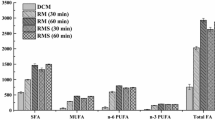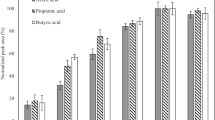Abstract
Dietary fatty acids can be both beneficial and detrimental to human health depending on the degree and type of saturation. Healthcare providers and research scientists monitor the fatty acid content of human plasma and serum as an indicator of health status and diet. In addition, both the Centers for Disease Control & Prevention (CDC) and the National Institutes of Health – Office of Dietary Supplements are interested in circulating fatty acids (FAs) because they may be predictive of coronary heart disease. The National Institute of Standards and Technology (NIST) provides a wide variety of reference materials (RMs) and Standard Reference Materials® (SRM®s) including blood, serum, plasma, and urine with values assigned for analytes of clinical interest. NIST SRM 2378 Fatty Acids in Frozen Human Serum was introduced in 2015 to help validate methods used for the analysis of FAs in serum, and consists of three different pools of serum acquired from (1) healthy donors who had taken fish oil dietary supplements (at least 1000 mg per day) for at least one month (level 1 material), (2) healthy donors who had taken flaxseed oil dietary supplements (at least 1000 mg per day) for at least one month (level 2 material), and (3) healthy donors eating “normal” diets who had not taken dietary supplements containing fish or plant oils (level 3 material). The use of dietary supplements by donors provided SRMs with natural endogenous ranges of FAs at concentrations observed in human populations. Results from analyses using two methods at NIST, including one involving a novel microwave-assisted acid hydrolysis procedure, and one at the CDC are presented here. These results and their respective uncertainties were combined to yield certified values with expanded uncertainties for 12 FAs and reference values with expanded uncertainties for an additional 18 FAs.

Similar content being viewed by others
References
Standard Reference Material 2378 Fatty Acids in Frozen Human Serum. 2–11-2017, https://www-s.nist.gov/srmors/view_cert.cfm?srm=2378.
Simopoulos AP. Essential fatty acids in health and chronic disease. Am J Clin Nutr. 1999;70:560S–9S.
Prasad K. Flaxseed: A source of hypocholesterolemic and antiatherogenic agents. Drug News Perspect. 2000;13:99–104.
Thies F, Miles EA, Nebe-von-Caron G, Powell JR, Hurst TL, Newsholme EA, et al. Influence of dietary supplementation with long-chain n-3 or n-6 polyunsaturated fatty acids on blood inflammatory cell populations and functions and on plasma soluble adhesion molecules in healthy adults. Lipids. 2001;36:1183–93.
Salem N, Pawlosky RJ. Health Policy Aspects of Lipid Nutrition and Early Development. Basel: Karger; 1994.
Chew EY, Clemons TE, SanGiovanni JP, Danis R, Ferris FL, Elman M, et al. Lutein plus Zeaxanthin and Omega-3 Fatty Acids for Age-Related Macular Degeneration The Age-Related Eye Disease Study 2 (AREDS2) Randomized Clinical Trial. J Am Med Assoc. 2013;309:2005–15.
Cui Y, Chen XB, Liu LY, Xie W, Wu Y, QH W, et al. Gas chromatography-mass spectrometry analysis of the free fatty acids in serum obtained from patients with Alzheimer's disease. Bio-Med. Mater Eng. 2015;26:S2165–77.
Harper CR, Edwards MJ, DeFilipis AP, Jacobson TA. Flaxseed oil increases the plasma concentrations of cardioprotective (n-3) fatty acids in humans. J Nutr. 2006;136:83–7.
Barcelo-Coblijn G, Murphy EJ, Othman R, Moghadasian MH, Kashour T, Friel JK. Flaxseed oil and fish-oil capsule consumption alters human red blood cell n-3 fatty acid composition: a multiple-dosing trial comparing 2 sources of n-3 fatty acid. Am J Clin Nutr. 2008;88:801–9.
In vitro diagnostic medical devices - Measurement of quantities in samples of biological origin - Requirement for content and presentation of reference measurment procedures. ISO 15193:2009. 2009. International Organization for Standardization (ISO), Switzerland.
Stellaard F, Tenbrink HJ, Kok RM, Vandenheuvel L, Jakobs C. Stable Isotope-Dilution Analysis of Very Long-Chain Fatty-Acids in Plasma, Urine and Amniotic-Fluid by Electron-Capture Negative-Ion Mass Fragmentography. Clin Chim Acta. 1990;192:133–44.
Tenbrink HJ, Stellaard F, Vandenheuvel CMM, Kok RM, Schor DSM, Wanders RJA, et al. Pristanic Acid and Phytanic Acid in Plasma from Patients with Peroxisomal Disorders - Stable Isotope-Dilution Analysis with Electron-Capture Negative-Ion Mass Fragmentography. J Lipid Res. 1992;33:41–7.
Lagerstedt SA, Hinrichs DR, Batt SM, Magera MJ, Rinaldo P, McConnell JP. Quantitative determination of plasma C8-C26 total fatty acids for the biochemical diagnosis of nutritional and metabolic disorders. Mol Genet Metab. 2001;73:38–45.
National Health and Nutrition Examination Survey: 2003–2004 Data Documentation, Codebook, and Frequencies; Fatty Acids - Plasma (Surplus) (SSFA_C). 2011. Centers for Disease Control and Prevention.
Zomer AWM, van der Burg B, Jansen GA, Wanders RJA, Poll-The B, van der Saag PT. Pristanic acid and phytanic acid: naturally occurring ligands for the nuclear receptor peroxisome proliferater-activated receptor alpha. J Lipid Res. 2000;41:1801–7.
Kaur G, Cameron-Smith D, Garg M, Sinclair AJ. Docosapentaenoic acid (22:5n-3): A review of its biological effects. Prog Lipid Res. 2011;50:28–34.
Second National Report on Biochemical Indicators of Diet and Nutrition in the U.S. Population. 2012. Centers for Disease Control and Prevention.
May W, Parris R, Beck C, Fassett J, Greenberg R, Guenther F, et al. Definitions of Terms and Modes Used at NIST for Value-Assignment of Reference Materials for Chemical Measurements. 260–136. Washington, DC: U.S. Government Printing Office; 2000.
Kato K, Silva MJ, Needham LL, Calafat AM. Determination of 16 phthalate metabolites in urine using automated sample preparation and on-line preconcentration/high-performance liquid chromatography/tandem mass spectrometry. Anal Chem. 2005;77:2985–91.
JCGM 100:2008; Evaluation of Measurement Data - Guide to the Expression of Uncertainty in Measurement. 2008.
Taylor BN, Kuyatt CE. Guidelines for Evaluating and Expressing the Uncertainty of NIST Measurement Results. NIST Technical Note 1297. 1994. Washington, DC, U.S. Government Printing Office.
JCGM 101:2008; Evaluation of Measurement Data - Supplement 1 to the Guide to the Expression of Uncertainty in Measurement-Propagation of Distributions using a Monte Carlo method . 2008.
Efron B, Tibshirani RJ. An Introduction to the Bootstrap. London: Chapman & Hall; 1993.
Schantz MM, Powers CD, Schleicher RL, Betz JM, Wise SA. Interlaboratory analytical comparison of fatty acid concentrations in serum or plasma. Clin. Chim Acta. 2016;462:148–52.
Acknowledgements
Partial financial support for the development and certification of SRM 2378 Fatty Acids in Frozen Human Serum was provided by the National Institutes of Health, Office of Dietary Supplements (NIH-ODS), with guidance from Joseph M. Betz (NIH-ODS) and Stephen A. Wise (NIST).
Author information
Authors and Affiliations
Corresponding author
Ethics declarations
The contractor who collected, processed, and packaged SRM 2378 was required to submit documentation to NIST of their relationship with an appropriate Institutional Review Board (IRB) registered with the US Department of Health and Human Services’ Office of Human Research Protections and located within the community in which the human subject research was conducted. The contractor also had to submit documentation for NIST institutional review and approval. The donors to SRM 2378 signed a form acknowledging that they had read information describing what their blood would be used for, that they had received answers to any questions, and that they gave consent for their blood to be pooled and used in the preparation of a serum SRM.
Disclaimers
Certain commercial equipment, instruments, or materials are identified in this report to specify adequately the experimental procedure. Such identification does not imply recommendation or endorsement by the National Institute of Standards and Technology, nor does it imply that the materials or equipment are the best available for the purpose. The findings and conclusions of the article are those of the authors and do not necessarily represent the official views or positions of the CDC/Agency for Toxic Substance and Disease Registry, the Department of Health and Human Services, or NIST.
Conflict of interest
This work represents no known conflicts of interest with respect to the authors or their institutions.
Electronic supplementary material
ESM 1
(PDF 942 kb)
Rights and permissions
About this article
Cite this article
Benner, B.A., Schantz, M.M., Powers, C.D. et al. Standard Reference Material (SRM) 2378 fatty acids in frozen human serum. Certification of a clinical SRM based on endogenous supplementation of polyunsaturated fatty acids. Anal Bioanal Chem 410, 2321–2329 (2018). https://doi.org/10.1007/s00216-017-0841-5
Received:
Revised:
Accepted:
Published:
Issue Date:
DOI: https://doi.org/10.1007/s00216-017-0841-5




